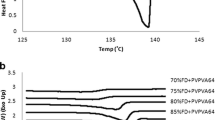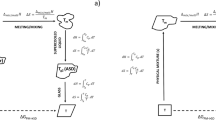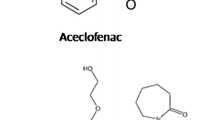Abstract
Purpose
Crystallization of drugs formulated in the amorphous form may lead to reduced apparent solubility, decreased rate of dissolution and bioavailability and compromise the physical integrity of the solid dosage form. The purpose of this work was to develop thermodynamic approaches, both practical and theoretical, that will yield a better understanding of which factors are most important for determining the ability of polymers to stabilize amorphous active pharmaceutical ingredients (API).
Materials and Methods
Lattice based solution models were used to examine miscibility criteria in API-polymer blends. Different methods were used to estimate the Flory‐Huggins interaction parameter for model API-polymer systems consisting of felodipine or nifedipine with poly(vinylpyrrolidone) (PVP). These were melting point depression and determination of solubility parameters using group contribution theory. The temperature and enthalpy of fusion of crystalline API alone and the fusion temperature of the API in the presence of the polymer were measured by differential scanning calorimetry. The resultant thermal data were used to estimate the reduced driving force for crystallization and the solubility of the API in the polymer.
Results
Flory‐Huggins theory predicts that, for typical API-polymer systems, the entropy of mixing is always favorable and should be relatively constant. Due to the favorable entropy of mixing, miscibility can still be achieved in systems with a certain extent of unfavorable enthalpic interactions. For the model systems, interaction parameters derived from melting point depression were negative indicating that mixing was exothermic. Using these interaction parameters and Flory‐Huggins theory, miscibility was predicted for all compositions, in agreement with experimental data. A model was developed to estimate the solubility of the API in the polymer. The estimated solubility of the model APIs in PVP is low suggesting that kinetic rather than thermodynamic stabilization plays a significant role in inhibiting crystallization.
Conclusions
The thermodynamics of API-polymer systems can be modeled using solution based theories. Such models can contribute towards providing an understanding of the compatibility between API and polymer and the mechanisms of physical stabilization in such systems.





Similar content being viewed by others
References
D. Law, S. L. Krill, E. A. Schmitt, J. J. Fort, Y. H. Qiu, W. L. Wang, and W. R. Porter. Physicochemical considerations in the preparation of amorphous ritonavir-poly(ethylene glycol) 8000 solid dispersions. J. Pharm. Sci. 90:1015–1025 (2001).
L. S. Taylor and G. Zografi. Spectroscopic characterization of interactions between PVP and indomethacin in amorphous molecular dispersions. Pharm. Res. 14:1691–1698 (1997).
D. Law, E. A. Schmitt, K. C. Marsh, E. A. Everitt, W. L. Wang, J. J. Fort, S. L. Krill, and Y. H. Qiu. Ritonavir-PEG 8000 amorphous solid dispersions: In vitro and in vivo evaluations. J. Pharm. Sci. 93:563–570 (2004).
T. Miyazaki, S. Yoshioka, Y. Aso, and S. Kojima. Ability of polyvinylpyrrolidone and polyacrylic acid to inhibit the crystallization of amorphous acetaminophen. J. Pharm. Sci. 93:2710–2717 (2004).
I. Weuts, D. Kempen, A. Decorte, G. Verreck, J. Peeters, M. Brewster, and G. Van den Mooter. Phase behaviour analysis of solid dispersions of loperamide and two structurally related compounds with the polymers PVP-K30 and PVP-VA64. Eur. J. Pharm. Sci. 22:375–385 (2004).
G. Van den Mooter, M. Wuyts, N. Blaton, R. Busson, P. Grobet, P. Augustijns, and R. Kinget. Physical stabilisation of amorphous ketoconazole in solid dispersions with polyvinylpyrrolidone K25. Eur. J. Pharm. Sci. 12:261–269 (2001).
K. Khougaz and S. D. Clas. Crystallization inhibition in solid dispersions of MK-0591 and poly(vinylpyrrolidone) polymers. J. Pharm. Sci. 89:1325–1334 (2000).
V. Tantishaiyakul, N. Kaewnopparat, and S. Ingkatawornwong. Properties of solid dispersions of piroxicam in polyvinylpyrrolidone K-30. Int. J. Pharm. 143:59–66 (1996).
H. Suzuki and H. Sunada. Influence of water-soluble polymers on the dissolution of nifedipine solid dispersions with combined carriers. Chem. Pharm. Bull. 46:482–487 (1998).
S. Sethia and E. Squillante. Solid dispersion of carbamazepine in PVPK30 by conventional solvent evaporation and supercritical methods. Int. J. Pharm. 272:1–10 (2004).
E. Broman, C. Khoo, and L. S. Taylor. A comparison of alternative polymer excipients and processing methods for making solid dispersions of a poorly water soluble drug. Int. J. Pharm. 222:139–151 (2001).
K. J. Crowley and G. Zografi. The effect of low concentrations of molecularly dispersed poly(vinylpyrrolidone) on indomethacin crystallization from the amorphous state. Pharm. Res. 20:1417–1422 (2003).
M. Fujii, J. Hasegawa, H. Kitajima, and M. Matsumoto. The solid dispersion of benzodiazepins with phosphatidylcholine–the effect of substituents of benzodiazepins on the formation of solid dispersions. Chem. Pharm. Bull. 39:3013–3017 (1991).
W. L. Chiou and S. Riegelma. Pharmaceutical applications of solid dispersion systems. J. Pharm. Sci. 60:1281–1302 (1971).
K. Six, C. Leuner, J. Dressman, G. Verreck, J. Peeters, N. Blaton, P. Augustijns, R. Kinget, and G. Van den Mooter. Thermal properties of hot-stage extrudates of itraconazole and eudragit E100–phase separation and polymorphism. J. Therm. Anal. Calorim. 68:591–601 (2002).
R. F. Fedors. Method for estimating both solubility parameters and molar volumes of liquids. Polym. Eng. Sci. 14:147–154 (1974).
J. H. Hildebrand and R. L. Scott. Solubility of Nonelectrolytes. Reinhold, New York, 1950.
P. J. Flory. Principles of Polymer Chemistry. Cornell University Press, Ithaca, 1953.
R. J. Young and P. A. Lovell. Introduction to Polymers. Nelson Thornes, Cheltenham, United Kingdom, 1991.
M. Rubinstein and Ralph H. Colby. Polymer Physics. Oxford University Press, New York, 2003.
P. C. Painter, J. F. Graf, and M. M. Coleman. Effect of hydrogen-bonding on the enthalpy of mixing and the composition dependence of the glass-transition temperature in polymer blends. Macromolecules 24:5630–5638 (1991).
M. M. Coleman, John F. Graf, and Paul C. Painter. Specific Interactions and the Miscibility of Polymer Blends. Technomic, Lancaster, Pennsylvania, 1991.
M. J. Newing. Thermodynamic studies of silicones in benzene solution. Trans. Faraday Soc. 46:613–620 (1950).
C. E. H. Bawn, R. F. J. Freeman, and A. R. Kamaliddin. High polymer solutions.1. Vapour pressure of polystyrene solutions. Trans. Faraday Soc. 46:677–684 (1950).
D. J. Greenhalgh, A. C. Williams, P. Timmins, and P. York. Solubility parameters as predictors of miscibility in solid dispersions. J. Pharm. Sci. 88:1182–1190 (1999).
B. C. Hancock, P. York, and R. C. Rowe. The use of solubility parameters in pharmaceutical dosage form design. Int. J. Pharm. 148:1–21 (1997).
A. Forster, J. Hempenstall, I. Tucker, and T. Rades. Selection of excipients for melt extrusion with two poorly water-soluble drugs by solubility parameter calculation and thermal analysis. Int. J. Pharm. 226:147–161 (2001).
P. J. Marsac, H. Konno, and L. S. Taylor. A comparison of the physical stability of amorphous felodipine and nifedipine systems. Pharm. Res. (in this issue) (2006).
X. L. C. Tang, M. J. Pikal, and L. S. Taylor. A spectroscopic investigation of hydrogen bond patterns in crystalline and amorphous phases in dihydropyridine calcium channel blockers. Pharm. Res. 19:477–483 (2002).
T. Nishi and T. T. Wang. Melting-point depression and kinetic effects of cooling on crystallization in poly(vinylidene fluoride) poly(methyl methacrylate) mixtures. Macromolecules 8:909–915 (1975).
E. Meaurio, E. Zuza, and J. R. Sarasua. Miscibility and specific interactions in blends of poly(L-lactide) with poly(vinylphenol). Macromolecules 38:1207–1215 (2005).
L. Mandelkern. Crystallization of Polymers. McGraw-Hill, New York, 1964.
Y. Hoei, K. Yamaura, and S. Matsuzawa. A lattice treatment of crystalline solvent-amorphous polymer mixtures on melting-point depression. J. Phys. Chem. 96:10584–10586 (1992).
R. Kaur, D. J. W. Grant, and T. Eaves. Comparison of polyethylene-glycol and polyoxyethylene stearate as excipients for solid dispersion-systems of griseofulvin and tolbutamide.1. Phase-equilibria. J. Pharm. Sci. 69:1317–1321 (1980).
S. E. Bartsch and U. J. Griesser. Physicochemical properties of the binary system glibenclamide and polyethylene glycol 4000. J. Therm. Anal. Calorim. 77:555–569 (2004).
C. Anastasiadou, S. Henry, B. Legendre, C. Souleau, and D. Duchene. Solid dispersions‐comparison of prepared melts and coprecipitates of diazepam and polyoxyethylene glycol-4000. Drug Dev. Ind. Pharm. 9:103–115 (1983).
L. S. Taylor, F. W. Langkilde, and G. Zografi. Fourier transform Raman spectroscopic study of the interaction of water vapor with amorphous polymers. J. Pharm. Sci. 90:888–901 (2001).
J. D. Hoffman. Thermodynamic driving force in nucleation and growth processes. J. Chem. Phys. 29:1192–1193 (1958).
B. R. Jasti, B. Berner, S. L. Zhou, and X. L. Li. A novel method for determination of drug solubility in polymeric matrices. J. Pharm. Sci. 93:2135–2141 (2004).
J. Breitenbach. Melt extrusion: from process to drug delivery technology. Eur. J. Pharm. Biopharm. 54:107–117 (2002).
S. H. Yalkowsky. Solubility and Solubilization in Aqueous Media. Oxford University Press, New York, 1999, pp. 49–80.
Acknowledgments
Alfred Rumondor is thanked for providing experimental solubility values. The PhRMA Foundation is acknowledged for a pre-doctoral fellowship to PJM. LST thanks AFPE/AACP for a New Investigator Award. AstraZeneca is thanked for financial support.
Author information
Authors and Affiliations
Corresponding author
Rights and permissions
About this article
Cite this article
Marsac, P.J., Shamblin, S.L. & Taylor, L.S. Theoretical and Practical Approaches for Prediction of Drug–Polymer Miscibility and Solubility. Pharm Res 23, 2417–2426 (2006). https://doi.org/10.1007/s11095-006-9063-9
Received:
Accepted:
Published:
Issue Date:
DOI: https://doi.org/10.1007/s11095-006-9063-9




